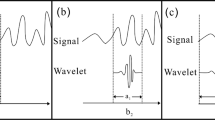Abstract
The identification of sandstone contrasting layers is a key step in the depth calibration of sandstone horizons, whose errors can cause large deviations in positioning results, which in turn affect subsequent drilling and production of oil wells. The identification of a sandstone contrast layer is calculated based on distinct response characteristics of well logging curves in the depth range of the layer. The identification of features of a well logging curve is generally made using the axial geological signals centered on the depth, combined with a time series similarity analysis of the data. However, when the local morphological features indicated and described by the curves corresponding to the depth of the sandstone reservoir are distinctly different, there will be differences in the features to obtained. To improve the accuracy in extracting similar features from well logging curves, we propose a similarity measurement method based on morphological characteristics to comprehensively analyze three morphological features of the curve sequence: the segmentation trend, fluctuation amplitude, and depth span. The similarity of the subsequence is measured according to the weighted slope difference of the comparative sequences. The method treats the attributes of similar waveform characteristics as a whole, which can overcome the shortcomings of conventional time series methods in describing the degree of morphological changes of the curves. Results from processing experimental data show that compared with the conventional method, the proposed method can effectively improve the accuracy in extracting the features of well logging curves and identifying the sandstone contrast layer.




Similar content being viewed by others
References
Cai Q, Chen L, Sun J (2015) Piecewise statistic approximation based similarity measure for time series. Knowl-Based Syst 85:181–195
Chen HY, Liu CH, Sun B (2017) Survey on similarity measurement of time series data mining. Control Decision 32(1):1–11
Dau HA, Silva DF, Petitjean F, Forestier G, Bagnall A, Mueen A, Keogh E (2018) Optimizing dynamic time warping’s window width for time series data mining applications. Data Min Knowl Disc 32(4):1074–1120
Esling P, Agon C (2012) Time-series data mining. ACM Computing Surveys (CSUR) 45(1):1–34
Fu TC (2011) A review on time series data mining. Eng Appl Artif Intell 24(1):164–181
Gao W, Shi L (2013) Ontology similarity measure algorithm with operational cost and application in biology science. BioTechnol Indian J 8(11):1572–1577
Górecki T (2018) Classification of time series using combination of DTW and LCSS dissimilarity measures. Commun Stat Simul Comput 47(1):263–276
He XG, Wang YY, Gao W (2013) Ontology similarity measure algorithm based on KPCA and application in biology science. J Chem Pharm Res 5(12):196–200
Höppner F (2017) Improving time series similarity measures by integrating preprocessing steps. Data Min Knowl Disc 31(3):851–878
Irani J, Pise N, Phatak M (2016) Clustering techniques and the similarity measures used in clustering: a survey. Int J Comput Appl 134(7):9–14
Izakian H, Pedrycz W, Jamal I (2015) Fuzzy clustering of time series data using dynamic time warping distance. Eng Appl Artif Intell 39:235–244
Kamalzadeh H, Ahmadi A, Mansour S (2019) Clustering time-series by a novel slope-based similarity measure considering particle swarm optimization. ArXiv Preprint ArXiv:1912.02405
Kate RJ (2016) Using dynamic time warping distances as features for improved time series classification. Data Min Knowl Disc 30(2):283–312
Marteau PF (2009) Time warp edit distance with stiffness adjustment for time series matching. IEEE Trans Pattern Anal Mach Intell 31(2):306–318
Mei J, Liu M, Wang YF, Gao H (2015) Learning a Mahalanobis distance-based dynamic time warping measure for multivariate time series classification. IEEE Trans Cybern 46(6):1363–1374
Paparrizos J, Gravano L (2017) Fast and accurate time-series clustering. ACM Trans Database Syst (TODS) 42(2):1–49
Serra J, Arcos JL (2014) An empirical evaluation of similarity measures for time series classification. Knowl-Based Syst 67:305–314
Wu YC, Rong G, Li ZX et al (2013) Short-term production scheduling optimization integrated with raw materials mixing process in petrochemical industry. Inf Technol J 12(19):4968–4976
Yan H (2018) C. Mass data storage and sharing algorithm in distributed heterogeneous environment. J Discret Math Sci Cryptogr 21(2):317–326
Zhu Y, Imamura M, Nikovski D, Keogh E (2019) Introducing time series chains: a new primitive for time series data mining. Knowl Inf Syst 60(2):1135–1161
Funding
The work described in this paper was fully supported by Philosophy and Social Science Fund of Heilongjiang Province, China (Project No. 19SHE280).
Author information
Authors and Affiliations
Corresponding author
Additional information
This article is part of the Topical Collection on Geological Modeling and Geospatial Data Analysis
Rights and permissions
About this article
Cite this article
Du, R., Chen, H., Shang, F. et al. A similarity measure recognized by morphological characteristics analysis of well logging curves: application to the knowledge domain of sandstone reservoir. Arab J Geosci 13, 947 (2020). https://doi.org/10.1007/s12517-020-05952-0
Received:
Accepted:
Published:
DOI: https://doi.org/10.1007/s12517-020-05952-0




